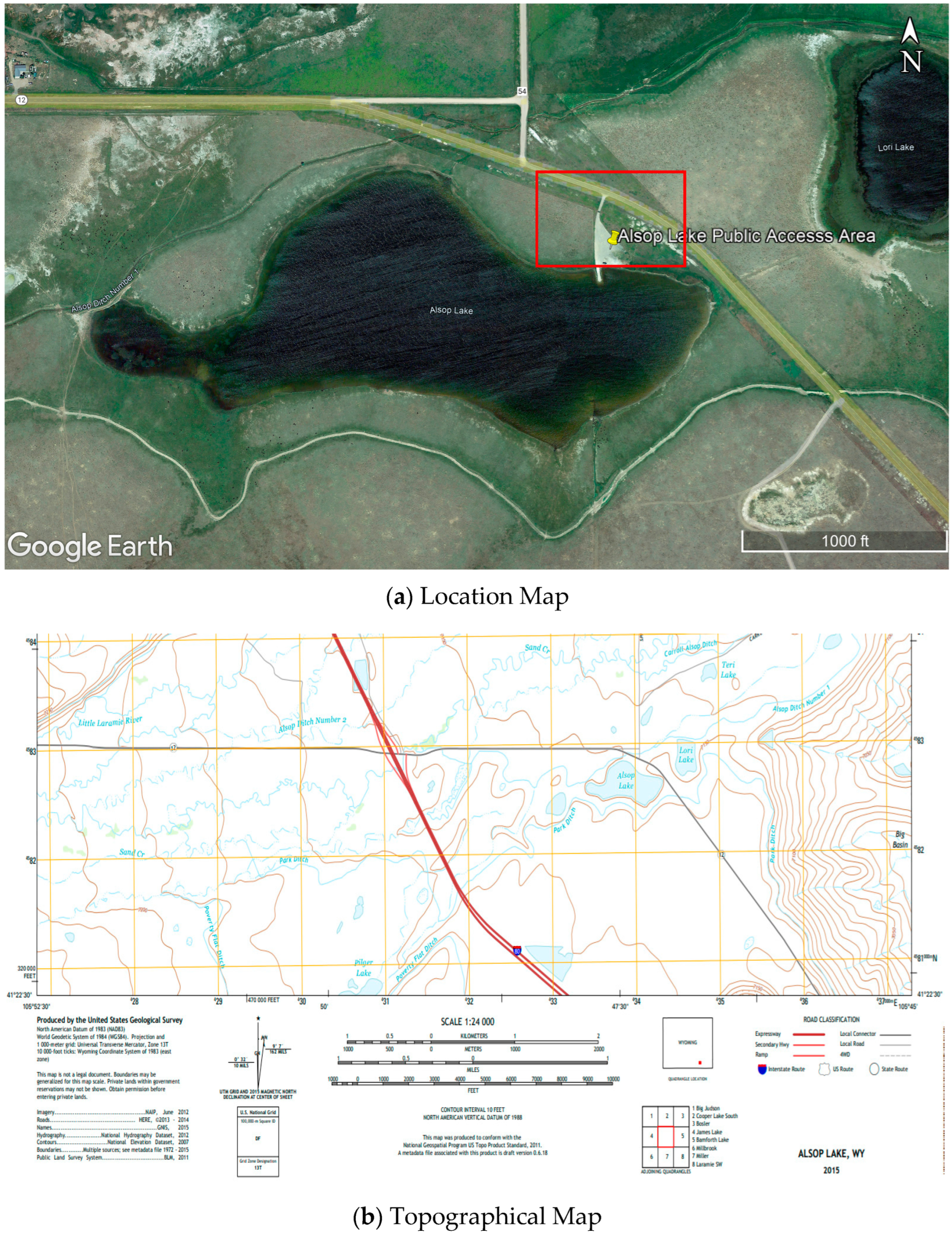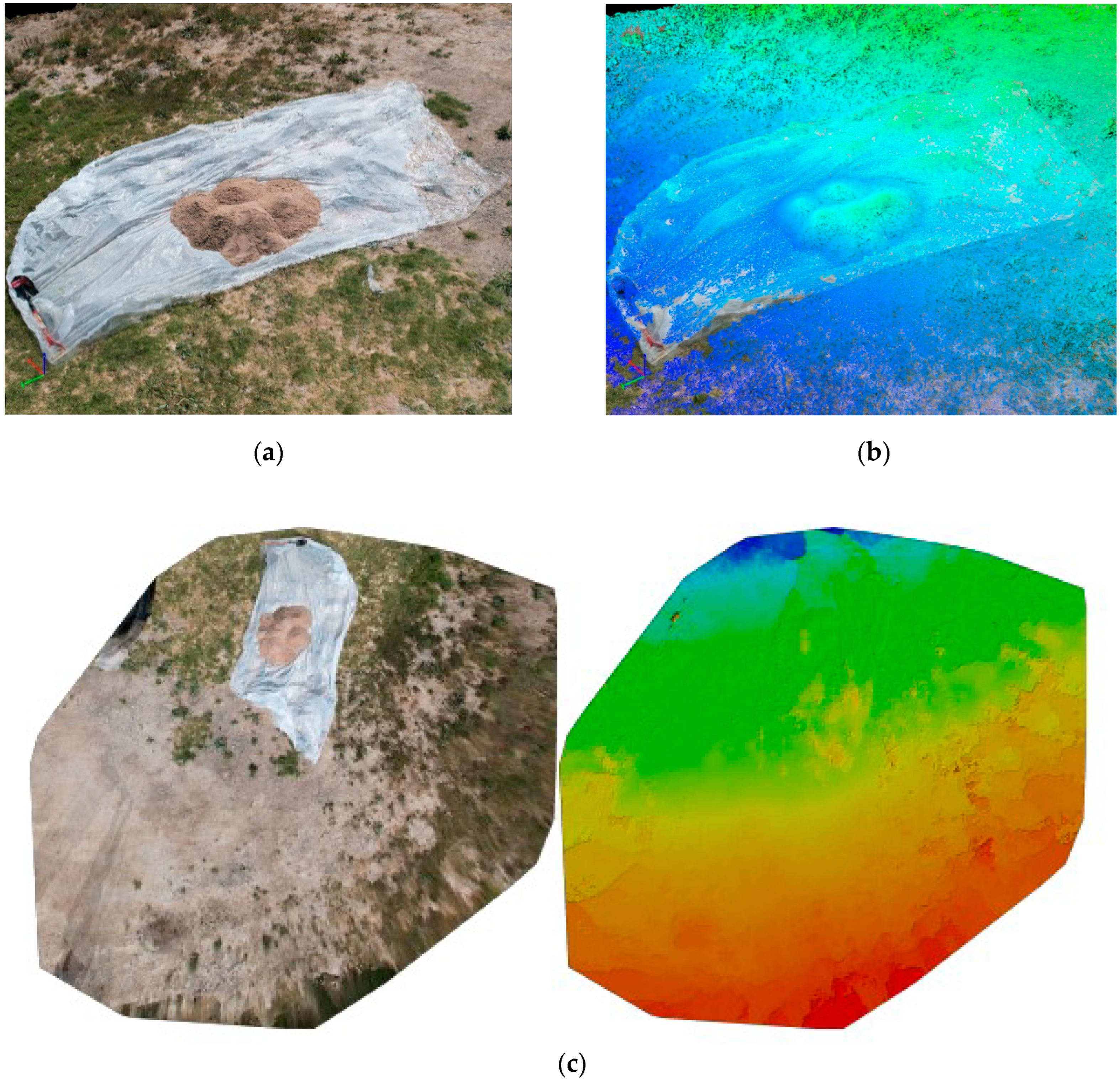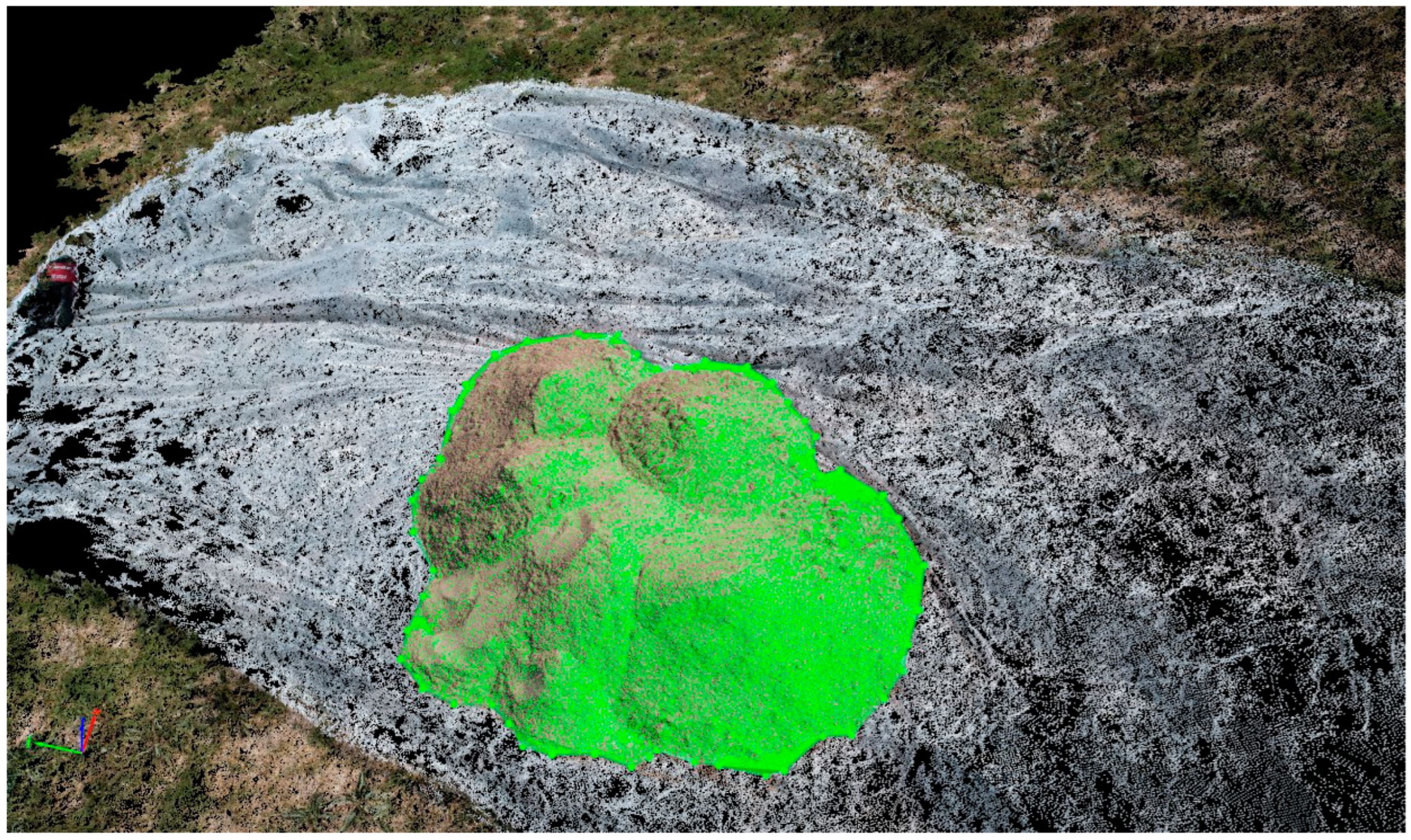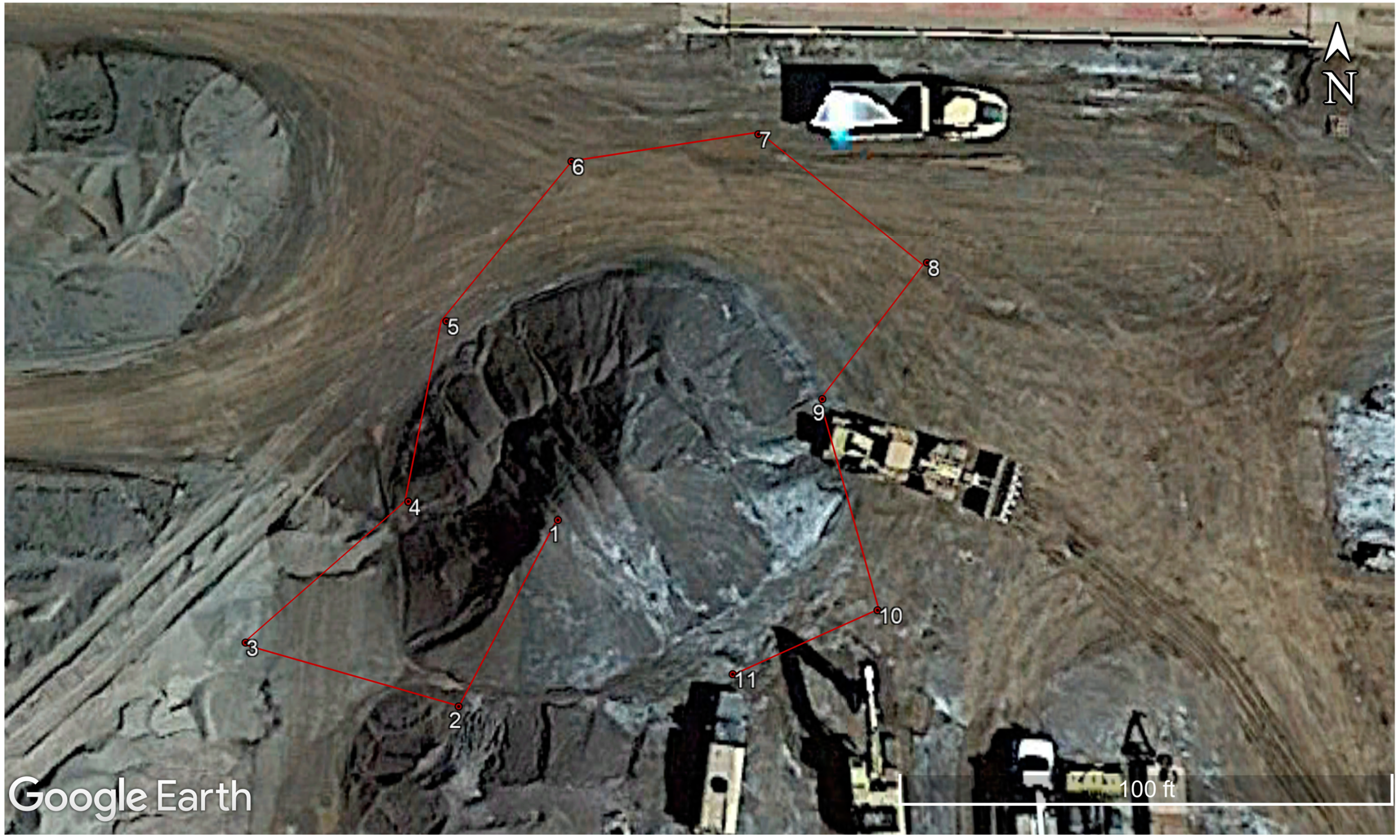Suitability Study of Using UAVs to Estimate Landfilled Fly Ash Stockpile
Abstract
1. Introduction
2. Methodology
2.1. Laboratory Analysis
2.1.1. Capture of Aerial Image
Selection of Equipment
Site Description
Capture Parameters
Length of Capture
2.1.2. Data Analysis and Validation
Data Processing
2.1.3. Data Validation
2.2. Case Study
3. Laboratory Analysis
3.1. Design of Experiment
3.2. Data Processing
3.3. Data Validation
4. Case Study
4.1. Capture of Aerial Image
4.2. Image Processing
4.3. Volumetric Analysis
5. Discussion
5.1. Challenges and Limitations
5.2. Benefits and Impact
6. Conclusions
Author Contributions
Funding
Institutional Review Board Statement
Informed Consent Statement
Data Availability Statement
Acknowledgments
Conflicts of Interest
References
- Davis, R.E.; Carlson, R.W.; Kelly, J.W.; Davis, H.E. Properties of Cements and Concrete containing Fly Ash. ACI J. 1937, 33, 577–612. [Google Scholar]
- Adams, T.H. Coal Ash Recycling Rate Increases in 2020, Reversing Declines in Previous Two Years; American Coal Ash Association (ACAA): Sandy, UT, USA, 2021. [Google Scholar]
- Wang, X.; Al-Shabbani, Z.; Sturgill, R.; Kirk, A.; Dadi, G.B. Estimating Earthwork Volumes through Use of Unmanned Aerial Systems. J. Transp. Res. Board 2017, 2630, 1–8. [Google Scholar] [CrossRef]
- Contreras, M.A.; Aracena, P. Improving Accuracy in Earthwork Volume Estimation for Proposed Forest Roads Using a High-Resolution Digital Elevation Model. Croat. J. For. Eng. 2012, 33, 125–142. [Google Scholar]
- Zhang, C.; Arditi, D. Automated progress control using laser scanning technology. Autom. Constr. 2013, 36, 108–116. [Google Scholar] [CrossRef]
- Dobrucali, E.; Demirkesen, S.; Sadikoglu, E.; Zhang, C.; Damci, A. Investigating the impact of emerging technologies on construction safety performance. Eng. Constr. Archit. Manag. 2022. ahead of print. [Google Scholar] [CrossRef]
- Horswell, J. Recording. Encyclopedia of Forensic Sciences, 2nd ed.; Academic Press: Cambridge, MA, USA, 2013; pp. 368–371. [Google Scholar]
- Wheeler, P. Use of Small Unmanned Aerial Systems for Land Surveying; U.S. Department of Transportation Federal Highway Administration (FHWA): Washington, DC, USA, 2019. [Google Scholar]
- Seibert, S.; Teizer, J. Mobile 3D mapping for surveying earthwork projects using an Unmanned Aerial Vehicle (UAV) system. Autom. Constr. 2014, 41, 1–14. [Google Scholar] [CrossRef]
- Jacob-Loyola, N.; Rivers, F.M.-L.; Herrera, R.F. Unmanned Aerial Vehicles (UAVs) for Physical Progress Monitoring of Construction. Sensors 2021, 21, 4227. [Google Scholar] [CrossRef] [PubMed]
- Kim, Y.H.; Shin, S.S.; Lee, H.K.; Park, E.S. Field Applicability of Earthwork Volume Calculations Using Unmanned Aerial Vehicle. Sustainability 2022, 14, 9331. [Google Scholar] [CrossRef]
- Hallermann, N.; Morgenthal, G. Unmanned Aerial Vehicles (UAV) for the Assessment of Existing Structures. In Proceedings of the IABSE Symposium: Long Span Bridges and Roofs—Development, Design and Implementation, Kolkata, India, 24–27 September 2013. [Google Scholar]
- Green, D.R.; Hagon, J.J.; Gomez, C.; Gregory, B.J. Chapter 21—Using Low-Cost UAVs for Environmental Monitoring, Mapping, and Modelling: Examples From the Coastal Zone. In Coastal Management; Academic Press: Cambridge, MA, USA, 2019; pp. 465–501. [Google Scholar]
- Nex, F.; Armenakis, C.; Cramer, M.; Cucci, D.; Gerke, M.; Honkavaara, E.; Kukko, A.; Persello, C.; Skaloud, J. UAV in the advent of the twenties: Where we stand and what is next. ISPRS J. Photogramm. Remote Sens. 2022, 184, 215–242. [Google Scholar] [CrossRef]
- Albeaino, G.; Gheisari, M.; Franz, B. A Systematic Review of Unmanned Aerial Vehicle Application Areas and Technologies in the AEC Domain. Electron. J. Inf. Technol. Constr. 2019, 24, 381–405. [Google Scholar]
- Rosca, S.; Suomalainen, J.; Bartholomeus, H.; Herold, M. Comparing terrestrial laser scanning and unmanned aerial vehicle structure from motion to assess top of canopy structure in tropical forests. Interface Focus 2018, 8, 20170038. [Google Scholar] [CrossRef]
- Cunha, R.R.; Arrabal, C.T.; Dantas, M.M.; Bassanelli, H.R. Laser scanner and drone photogrammetry: A statistical comparison between 3-dimensional models and its impacts on outdoor crime scene registration. Forensic Sci. Int. 2022, 330, 111100. [Google Scholar] [CrossRef] [PubMed]
- Zeng, X.; Meng, X.; Zhang, Y.; Dai, W.; Fang, N.; Shi, Z. Estimation of the volume of sediment deposited behind check dams based on UAV remote sensing. J. Hydrol. 2022, 612, 128143. [Google Scholar] [CrossRef]
- Tamin, M.A.; Darwin, N.; Majod, Z.; Ariff, M.F.M.; Idris, K.M.; Saman, A.M. Volume Estimation of Stockpile Using Unmanned Aerial Vehicle. In Proceedings of the 2019 9th IEEE International Conference on Control System, Computing and Engineering (ICCSCE), Penang, Malaysia, 29 November–1 December 2019. [Google Scholar]
- Hugenholtz, C.H.; Walker, J.; Brown, O.; Steve, M. Earthwork Volumetrics with an Unmanned Aerial Vehicle and Softcopy Photogrammetry. J. Surv. Eng. 2015, 141, 06014003. [Google Scholar] [CrossRef]
- Filkin, T.; Sliusar, N.; Huber-Humer, M.; Ritzkowski, M.; Korotaev, V. Estimation of dump and landfill waste volumes using unmanned aerial systems. Waste Manag. 2022, 139, 301–308. [Google Scholar] [CrossRef] [PubMed]
- Arango, C.; Morales, C. Comparison between Multicopter UAV and Total Station for Estimating Stockpile Volumes. In Proceedings of the International Conference on Unmanned Aerial Vehicles in Geomatics, Toronto, ON, Canada, 30 August–2 September 2015. [Google Scholar]
- DJI. DJI Air 2S. Available online: https://www.dji.com/air-2s?site=brandsite&from=nav (accessed on 23 November 2022).
- DJI. D. A. 2S, User Manual v1.0; DJI: Shenzhen, China, 2021. [Google Scholar]
- McNabb, M. Flying a Drone in the Wind, Cold, and Other Challenging Environments. 2021. Available online: https://dronelife.com/2021/06/28/flying-a-drone-in-the-wind-and-challenging-environments/ (accessed on 23 November 2022).
- Yang, X.; Huang, Y.; Zhang, Q. Automatic Stockpile Extraction and Measurement Using 3D Point Cloud and Multi-Scale Directional Curvature. Remote Sens. 2020, 12, 960. [Google Scholar] [CrossRef]
- Raeva, P.L.; Filipova, S.; Filipov, D. Volume computation of a stockpile-a study case comparing GPS and UAV measurements in an open pit quarry. In Proceedings of the International Archives of the Photogrammetry, Remote Sensing and Spatial Information Sciences, Prague, Czech Republic, 12–19 July 2016; Volume 41. [Google Scholar]
- Becker, C.; Rosinskaya, E.; Hani, N.; D’Angelo, E.; Strecha, C. Classification of Aerial Photogrammetric 3D Point Clouds. Photogramm. Eng. Remote Sens. 2018, 84, 287–295. [Google Scholar] [CrossRef]
- Khanna, R.; Moller, M.; Pfeifer, J.; Leibisch, F.; Walter, A.; Seigwart, R. Beyond point clouds—3D mapping and field parameter measurements using UAVs. In Proceedings of the 2015 IEEE 20th Conference on Emerging Technologies & Factory Automation (ETFA), Luxembourg, 8–11 September 2015. [Google Scholar]
- Draeyer, B.; Strecha, C. Pix4D White Paper: How Accurate Are UAV Surveying Methods? 2017. Available online: https://www.flyingsaucersolutions.com/wp-content/uploads/2016/09/UAV-Surveying.pdf (accessed on 20 November 2022).
- Stockpile Volume Calculation with Photogrammetry. 2017. Available online: https://www.pix4d.com/blog/drone-mining-stockpile-volume-pix4dmapper (accessed on 23 November 2022).
- Bhatt, A.; Priyadarshini, S.; Mohanakrishnan, A.A.; Abri, A.; Sattler, M.; Techapaphawit, S. Physical, chemical, and geotechnical properties of coal fly ash: A global review. Case Stud. Constr. Mater. 2019, 11, e00263. [Google Scholar] [CrossRef]
- Pofale, A.D.; Deo, S.V. A study of fine aggregate replacement with fly ash an environmental friendly and economical solution. J. Environ. Sci. Eng. 2010, 52, 373–378. [Google Scholar] [PubMed]
- Pix4D. Which Base Surface is recommended for the Volume Calculation? 2011. Available online: https://support.pix4d.com/hc/en-us/articles/217114246-Which-Base-Surface-is-recommended-for-the-Volume-Calculation (accessed on 7 January 2023).
- Pix4D. Step 4. Processing—Support. Available online: https://support.pix4d.com/hc/en-us/articles/202557519-Step-4-Processing (accessed on 23 November 2022).
- He, H.; Chen, T.; Zeng, H.; Huang, S. Ground Control Point-Free Unmanned Aerial Vehicle-Based Photogrammetry for Volume Estimation of Stockpiles Carried on Barges. Sensors 2019, 19, 3534. [Google Scholar] [CrossRef] [PubMed]







| Altitude (Meters) | Frequency |
|---|---|
| 2.5 | 17 |
| 3 | 12 |
| 5 | 12 |
| Total | 41 |
| Flight Altitude (m) | Total Number of Images | Number of Images Processed in Phase I | Number of Images Processed in Phase II |
|---|---|---|---|
| 2.5 | 17 | 17 | 6 |
| 3.5 | 12 | 12 | 6 |
| 5 | 12 | 12 | 7 |
| Total | 41 | 41 | 19 |
| Phase | Flight Altitude (m) | Number of Images | Calculated Volume (m3) | Actual Volume (m3) | Error | Average Error |
|---|---|---|---|---|---|---|
| I | 2.5 | 17 | 0.33 | 0.14 | 135% | 89% |
| II | 6 | 0.2 | 43% | |||
| I | 3.5 | 12 | 0.12 | 0.14 | 14% | 21.5% |
| II | 6 | 0.10 | 29% | |||
| I | 5 | 12 | 0.12 | 0.14 | 14% | 17.5% |
| II | 7 | 0.11 | 21% |
| Location | Frequency |
|---|---|
| L1 | 6 |
| L2 | 4 |
| L3 | 2 |
| L4 | 2 |
| L5 | 7 |
| L6 | 2 |
| L7 | 3 |
| L8 | 15 |
| L9 | 5 |
| L10 | 9 |
| L11 | 15 |
| Total | 65 |
| Calculated Volume (m3) | Actual Volume (m3) |
|---|---|
| 1453.22 | 1649.14 |
| Quality Report Requirement | Laboratory Study | Case Study |
|---|---|---|
| Image Calibration = 100% | 100% | 100% |
| The relative difference between initial and optimized internal camera parameters < 5% | 0.81% | 0.63% |
| Quality of Orthomosaic | No holes and distortions | No holes and distortions |
| Overlap quality | Good | Good |
| Image Coordinate System | Correct | Correct |
| Absolute camera position uncertainty (Sigma < Mean) | Sigma < Mean | Sigma < Mean |
Disclaimer/Publisher’s Note: The statements, opinions and data contained in all publications are solely those of the individual author(s) and contributor(s) and not of MDPI and/or the editor(s). MDPI and/or the editor(s) disclaim responsibility for any injury to people or property resulting from any ideas, methods, instructions or products referred to in the content. |
© 2023 by the authors. Licensee MDPI, Basel, Switzerland. This article is an open access article distributed under the terms and conditions of the Creative Commons Attribution (CC BY) license (https://creativecommons.org/licenses/by/4.0/).
Share and Cite
Kuinkel, M.S.; Zhang, C.; Liu, P.; Demirkesen, S.; Ksaibati, K. Suitability Study of Using UAVs to Estimate Landfilled Fly Ash Stockpile. Sensors 2023, 23, 1242. https://doi.org/10.3390/s23031242
Kuinkel MS, Zhang C, Liu P, Demirkesen S, Ksaibati K. Suitability Study of Using UAVs to Estimate Landfilled Fly Ash Stockpile. Sensors. 2023; 23(3):1242. https://doi.org/10.3390/s23031242
Chicago/Turabian StyleKuinkel, Muskan Sharma, Chengyi Zhang, Peng Liu, Sevilay Demirkesen, and Khaled Ksaibati. 2023. "Suitability Study of Using UAVs to Estimate Landfilled Fly Ash Stockpile" Sensors 23, no. 3: 1242. https://doi.org/10.3390/s23031242
APA StyleKuinkel, M. S., Zhang, C., Liu, P., Demirkesen, S., & Ksaibati, K. (2023). Suitability Study of Using UAVs to Estimate Landfilled Fly Ash Stockpile. Sensors, 23(3), 1242. https://doi.org/10.3390/s23031242








